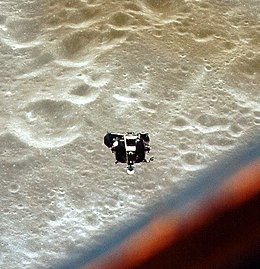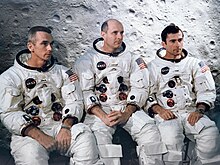Apollo 10

Apollo 10's Lunar Module, Snoopy, approaches the Command/Service Module Charlie Brown for redocking
|
|
| Mission type | F |
|---|---|
| Operator | NASA |
| COSPAR ID |
|
| SATCAT № |
|
| Mission duration | 8 days, 3 minutes, 23 seconds |
| Spacecraft properties | |
| Spacecraft |
|
| Manufacturer |
|
| Launch mass | 98,273 pounds (44,576 kg) |
| Landing mass | 10,901 pounds (4,945 kg) |
| Crew | |
| Crew size | 3 |
| Members | |
| Callsign |
|
| Start of mission | |
| Launch date | May 18, 1969, 16:49:00 UTC |
| Rocket | Saturn V SA-505 |
| Launch site | Kennedy LC-39B |
| End of mission | |
| Recovered by | USS Princeton |
| Landing date | May 26, 1969, 16:52:23 UTC |
| Landing site | 15°2′S 164°39′W / 15.033°S 164.650°W |
| Orbital parameters | |
| Reference system | Selenocentric |
| Periselene | 109.6 kilometers (59.2 nmi) |
| Aposelene | 113.0 kilometers (61.0 nmi) |
| Inclination | 1.2 degrees |
| Period | 2 hours |
| Lunar orbiter | |
| Spacecraft component | Command/Service Module |
| Orbital insertion | May 21, 1969, 20:44:54 UTC |
| Departed orbit | May 24, 1969, 10:25:38 UTC |
| Orbits | 31 |
| Lunar orbiter | |
| Spacecraft component | Lunar Module |
| Orbits | 4 |
| Orbit parameters | |
| Periselene | 14.4 kilometers (7.8 nmi) |
| Docking with LM | |
| Docking date | May 18, 1969, 20:06:36 UTC |
| Undocking date | May 22, 1969, 19:00:57 UTC |
| Docking with LM Ascent Stage | |
| Docking date | May 23, 1969, 03:11:02 UTC |
| Undocking date | May 23, 1969, 05:13:36 UTC |
 Left to right: Cernan, Stafford, Young |
|
Apollo 10 was the fourth manned mission in the United States Apollo space program, and the second (after Apollo 8) to orbit the Moon. Launched on May 18, 1969, it was the F mission: a "dress rehearsal" for the first Moon landing, testing all of the components and procedures, just short of actually landing. The Lunar Module (LM) followed a descent orbit to within 8.4 nautical miles (15.6 km) of the lunar surface, at the point where powered descent for landing would normally begin. Its success enabled the first landing to be attempted on the Apollo 11 mission two months later.
According to the 2002 Guinness World Records, Apollo 10 set the record for the highest speed attained by a manned vehicle: 39,897 km/h (11.08 km/s or 24,791 mph) on May 26, 1969, during the return from the Moon.
The mission's call signs included the names of the Peanuts characters Charlie Brown and Snoopy, which became Apollo 10's semi-official mascots.Peanuts creator Charles Schulz also drew some mission-related artwork for NASA.
Apollo 10, along with Apollo 11, were the only Apollo missions whose crew were all veterans of spaceflight. Thomas P. Stafford had flown on Gemini 6 and Gemini 9; John W. Young had flown on Gemini 3 and Gemini 10, and Eugene A. Cernan had flown with Stafford on Gemini 9.
...
Wikipedia

